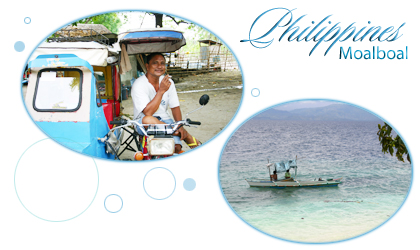
When to go
The climate of the Philippines is tropical with an average year-round temperature of 32șC and water temperatures averaging at about 28șC. From March to May it is always hot and dry, the coolest from December till February. June till September is considered the low season with more chance of encountering rain, which mainly falls late afternoon or at night. However, Bohol is a year round destination to visit and the chances of encountering "bad weather" are normally very slim.
Getting there
There are daily flights to Cebu with a number of airlines via the respective hubs. The flight from London to Cebu takes about 15 hours in total, not including the connection times in the relevant hub cities.
At Cebu airport you will be picked up by a resort representative and taken to Panagsama Beach, which is roughly a three hour drive.
Getting around
The most popular and cheapest way to get around this island and for short journeys is by Tricycle, which you will find at pretty much every street corner. However, be aware that the drivers will charge foreigners at least 10 times more than the locals, which for our consideration is still extremely cheap. You should always haggle before getting in to get the price to a reasonable level. As an example, you should not really pay more than about P100 to get from Panagsama Beach to White Beach, which is a 15 minute journey.
Entry Requirements
For stays of up to 21 days, most European community nationals require a valid passport with a minimum of 6 months validity from the date of arrival, as well as a return ticket.
Local Airport Tax
The international departure tax is P550, payable at Cebu airport
Language
The national language is Filipino, which is based on the language of Tagalog, and there are at least one or two dialects spoken in every region. The Philippines is currently the third-largest English speaking country in the world and English is both spoken and understood throughout the country.
Money
The official currency is the Philippine Peso. Most foreign currencies can be exchanged at banks, hotels and authorised foreign exchange dealers. Traveller's cheques are widely accepted, as are all major credit cards. However, outside of Manila and apart from credit cards, the Philippine Peso is the preferred and recommended form of payment.
Health
There are no vaccinations required to enter the Philippines. Even though the Philippines is a tropical country with some of the usual tropical diseases, it is unlikely that with a few basic precautions you will experience anymore than maybe jetlag, an upset stomach or a sunburn.
|


